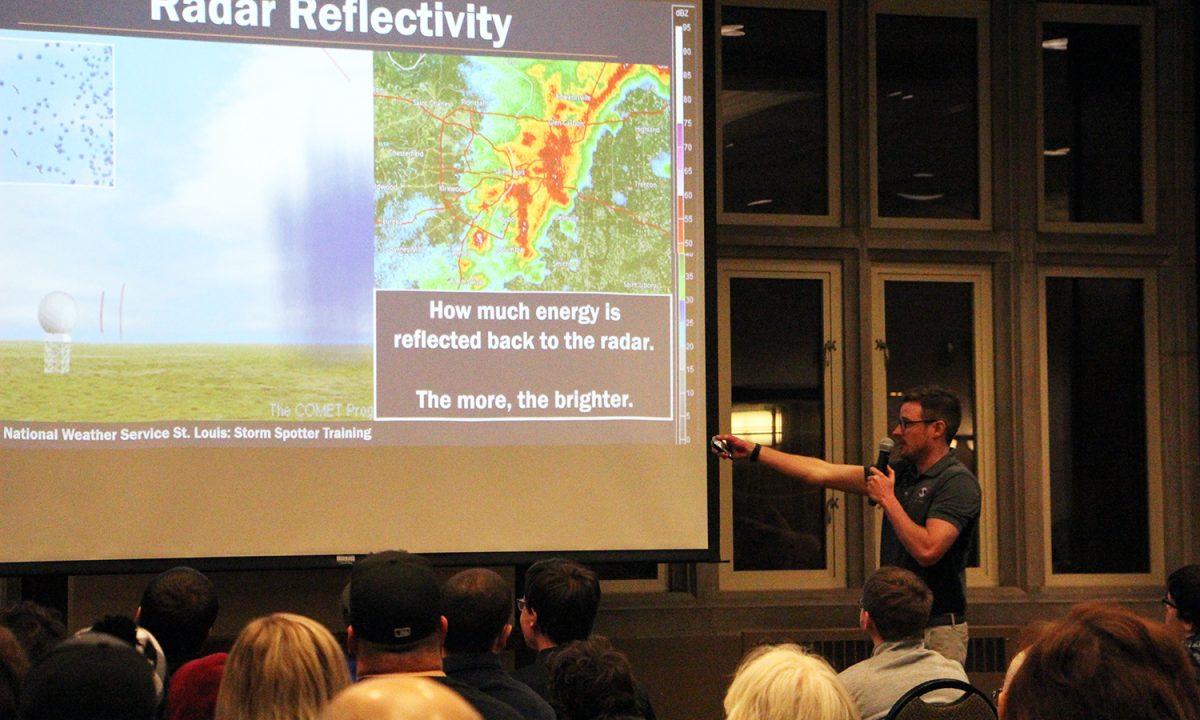
106 students and local residents gathered in Memorial Student Union for Skywarn Storm Spotter Training, an event held by the National Weather Service of St. Louis on Thursday, according to event organizers. NWS relies on trained spotters to improve their issuing of storm watches and warnings.
The event’s audience was comprised largely of professional meteorologists, amateur weather experts and meteorology students, but also containing members of the general public.
Tom Hurley, deputy director of the Boone County Office of Emergency Management Services, introduced the event.
“You give us information that is invaluable, you are our ears and eyes out in the field.” Hurley said.
Kevin Dietsch of NWS’s St. Louis office gave the bulk of the presentation, teaching those in attendance about the dangers of storms, how to spot certain types of storms and how to report them to NWS to improve public safety. He also made clear that while storm spotting is a vital part of NWS’ ability to keep people safe, storm chasing is a very different matter.
“The NWS does not condone, endorse or recommend storm chasing,” Dietsch said during the presentation. “It is a dangerous practice and should not be attempted.”
Dietsch’s presentation was interactive and included polls and audience participation. At one point, attendees were shown videos of heavy winds and asked what speed they thought the winds were in a poll.
This was meant to show that people tend to report winds as being much higher than they actually are. The threshold for severe wind that should be reported is 58 mph, or when damage begins to occur, said Dietsch.
Other types of severe weather that spotters report to NWS are hail the size of a quarter or larger, flash floods, snow or ice and tornadoes. Attendees were taught how to spot storms that might develop into tornadoes, as well as how to distinguish between a tornado and storms that look similar but are far less dangerous.
Spotters are needed for NWS reports because radar is not always accurate for what is happening on the ground, especially in Columbia. The radar is located in St. Charles and is at an angle meaning that the further away a given place is the further off the ground the storms that the radar is reporting are. The lowest objects that the radar can see in Columbia are 6,000 to 7,000 feet in the air due to the scan angle, Dietsch said during the presentation. For this reason it is vital to have an on-ground source of information, and that is where spotters come in.
“Our spotters really are our eyes and ears on the ground we learn so much from them that we can’t get from anywhere else,” Dietsch said.
Severe weather sirens were also discussed at the training. There are 74 sirens in Columbia with 3 located on MU’s campus, and they are tested the first Wednesday of every month at noon, said Hurley.
The event was put on by Campus Activities, specifically junior Annika Meyer who said she heads the Safe Mizzou initiative.
“We wanted to teach students and the public about being safe in storms and how to spot storms,” Meyer said.
She was thrilled that the event had a large turnout.
“I think we had a really good turnout,” Meyer said. “I honestly wasn’t sure what to expect but I think we have a good mix of students and the public.”
For those who were not in attendance, Dietsch had some advice when dealing with severe weather.
“Just be aware of what’s going on,” Dietsch said. “Have a plan and have ways of getting updates on the situation. With any severe weather situation, you want to be as aware as possible.”
_Edited by Emily Wolf | [email protected]_